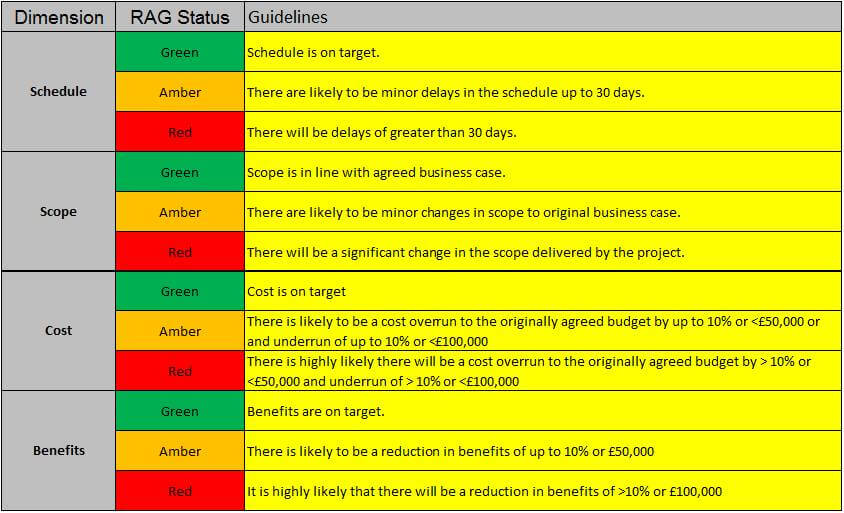It is expected that every project will report progress and status on a regular basis. The reason for this being that the sponsor and other stakeholders want the comfort of knowing they have visibility of progress. This helps ensure that there are no nasty surprises and, if the project is having challenges, it ensures that the sponsor and stakeholders are aware and gives them the opportunity to take corrective action (or stop the project before more money is spent).
It is very common for a project status to be reported by RAG. RAG being the acronym for Red, Amber, Green. The basic principle is:
- Green = project is on track
- Amber = some issues, being managed, needs to be closely monitored
- Red = serious issues, dates being missed, recovery plan required
This simple approach makes it very easy for the projects at risk or in trouble to be identified and action taken.
Consistent RAG Reporting
It is very important for an organisation to be able to understand the trust what status is being reported for a project. Therefore, it is very important to have clearly defined criteria for selecting the correct RAG status. Having a standard definition for each status will reduce reporting inconsistencies such as where one project manager is very hard on their reporting where as another is very relaxed.
The aim of the definitions is to ensure that all projects of a similar status are reported using the same RAG.
PMO Actions
1. RAG Definition
Define sensible definitions and criteria to be used to set RAGs for:
- Scope
- Schedule
- Costs
- Benefits
- Overall Status
You can also include other dimensions such as Resources.
Make sure that the definition and criteria for each makes sense, is easy to understand and does not involve subjectivity.
2. Document and Publish RAG Definitions
The PMO must ensure that the RAG reporting definitions and criteria are clearly communicated, especially to the project managers. Time should be spent checking with the project managers to ensure a common understanding.
3. PMO Review of Project Reports
As part of the review process of all project report submissions, the PMO should check the RAG status on each project to:
- Ensure the project is using a RAG that reflects status
- Ensure that RAGs are being consistently applied across all projects
Other tips and ideas
It is very common for a project to start move to Amber and then remain at Amber for the duration of the project. This is not very helpful for monitoring progress. To overcome this you can look to define further granularity for each RAG setting:
- Green 1
- Amber 2
- Amber 3
- Red 4
- Red 5
Then when a project moves to Amber 2, it is highly likely it will move between Amber 2 and Amber 3. This gives a better indication if the project is improving or deteriorating.
Another similar approach is to combine Red, Amber, Green with an arrow:
- Up Arrow = status improving
- Down Arrow = status deteriorating
- Side Arrow = status remains the same
Whatever approach is chosen, just make sure that there is a clear definition and criteria to ensure the consistent application.
In summary
- RAG is one of the universal standards for reporting project status
- It is important that the definition and criteria is clearly defined and communicated
- Independent review (normally by PMO) is critical to ensure consistency
- Further granularity is possible using numbers or arrows






